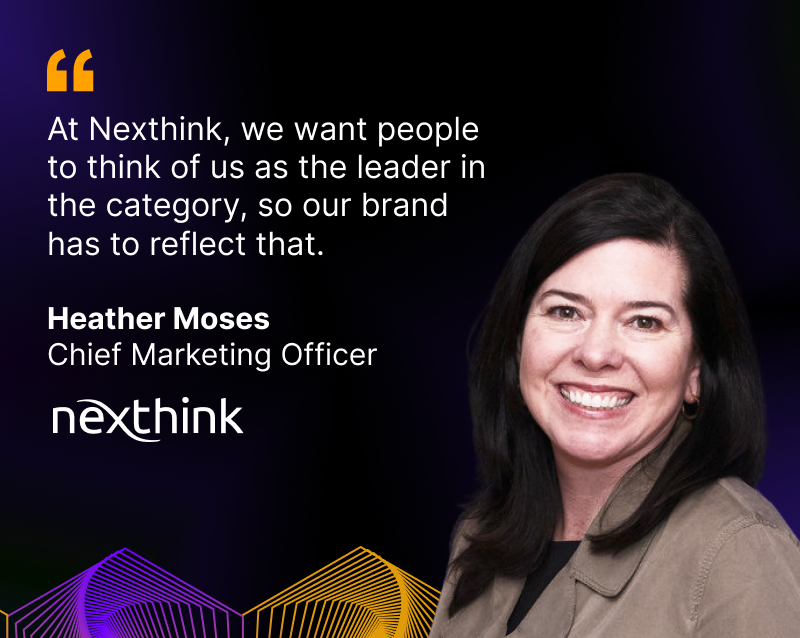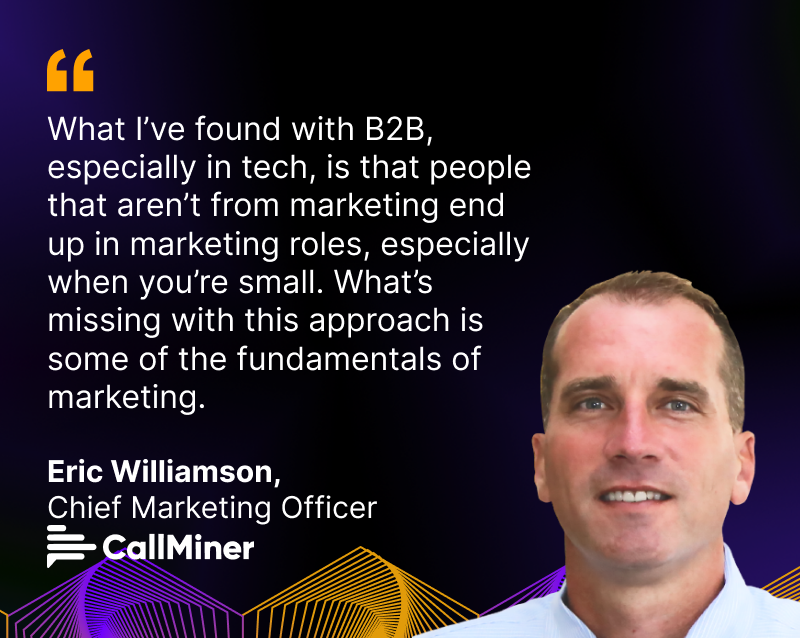Building B2B Brands and Communities: Meet Heather Moses from Nexthink and Eric Williamson from CallMiner

Maximize Your Marketing ROI
Join 10,000 other marketers already getting the best tips on running engaging events that boost pipeline and create raving fans.
In this episode of CMO Diaries, Kishore chatted with two inspiring B2B leaders who are making waves in SaaS marketing.
Our first guest is Heather Moses, Senior Vice President of Marketing at Nexthink. Nexthink is an AI-powered employee experience management platform that shines a light on all aspects of an employee's digital journey. Nexthink helps IT teams provide proactive support to employees and helps employees do their best work every day.Our second guest is Eric Williamson, Chief Marketing Officer at CallMiner. Also powered by AI and machine learning, CallMiner delivers the industry’s most powerful conversation analytics solution. The platform helps customer service centers ingest calls and chats to provide coaching to individual reps and bubble up insights to product teams.

People are trying to figure out how to build B2B communities. Is “community” a buzzword or a real strategy?
Heather:
Well, this could be considered a buzzword, but it's definitely not for Nexthink. We are very focused on our community.
We think about community not only as a resource for our customers, but also for category creation, which for us means building a broad community around the digital employee experience. We know there is a community of people that want to change things; we call them “IT Change Makers.” So, we’re building a community around people looking to disrupt and innovate in this space.
One thing we’ve done to support our community is launch the DEX HUB. It’s a place where people can come learn about the digital employee experience, see what’s happening in these careers, and find and connect with other “IT Change Makers” around the world. The hub isn’t centered around us as a company but around the category as a whole.
We also use the Hub as a place to highlight key leaders in this space and share interesting perspectives through blogs, podcasts, digital assets, etc. We want to provide anything that one could need to help further the mission around the category.
Eric:
I agree that—especially in B2B—community should be some portion of your overall strategy.
Before joining CallMiner, I was at a company called Acquia. They are a digital experience platform built on an open-source technology called Drupal. I recommend folks look into some of the philosophy behind open source; it’s essentially 100% community-based in terms of the developers that contribute.
Then look at Red Hat and any of the open-source brands. They make community the heart of their value proposition and offering is. So, even if your technology is not open source, there's a lot to learn from it.
At CallMiner, we have CallMiner Customer Connect, which is a community of our customers. It’s really geared towards folks that use the product on a day-to-day basis (and not so much the executives purchasing the product). We feed the community content and news to start conversations, but that peer-to-peer exchange of ideas and interaction is extremely valuable.
“We feed the community content and news to start conversations, but that peer-to-peer exchange of ideas and interaction is extremely valuable.”
Most B2B companies are doing some version of that. It’s hard to do, and it’s hard to do well. We use a portal platform to help—there’s several good ones out there. The real key is dedicating resources to the community so you can get that engagement. And, you want to segment it appropriately.
For example, we tapped our community when the pandemic started. We work with a lot of call centers, and those agents typically work together in-person at a service center. Then all of a sudden, these agents shifted to working from home very quickly. Some of them had tech that would support their needs and some didn’t. We facilitated a think tank among all of our customers to operationalize how call center agents could work from. It was a godsend to a lot of customers. And it wasn’t something we had to produce—the community came together and worked collaboratively to share this knowledge.
Our community at CallMiner is intentionally exclusive to our customers only. We do a lot of thought leadership and content on the prospect side to help sales but not to the degree and from the peer-to-peer standpoint that we offer to our customer community. We even use it as part of our value proposition alongside customer support and professional services—we talk about the value of the community.
How can companies build great brands? How do you think about brand?
Heather:
One thing we did last year, which was really fun from a design perspective, was to bring 3D elements into our branding. We did photo shoots with props to bring the branding and the elements we use to life.
In terms of ensuring we have the best brand, a lot of what we spend our time on is category creation. Defining “what is ‘digital employee experience?’” For us, it’s a different way to do IT. It’s a different way to work. At Nexthink, we want people to think of us as the leader in the category, so our brand has to reflect that.

From a brand perspective, for us it’s about being consistent. It’s about taking risks and being creative. And it’s about making sure that everything that we’re doing is to educate and, to a degree, entertain our audience. Because who doesn’t want to be entertained?
We’re always trying to think outside of the box and test new things. Some land, and some don’t. But that’s the fun of marketing.
Eric:
Before jumping into B2B technology, I worked for two big ad agencies. We worked with really impressive brands like Microsoft, Google, Acura, JetBlue—almost exclusively B2C. I think there’s a lot B2B marketers can learn from B2C companies.
What I’ve found with B2B, especially in tech, is that people that aren’t from marketing end up in marketing roles, especially when you’re small. Maybe you’re in product or sales and somehow ended up in marketing.
What’s missing with this approach is some of the fundamentals of marketing. Things like how to put together a proper creative or campaign brief; how to think about the value or brand versus demand generation and figure out that mix; what’s the proper creative process, and how to give feedback.

When you’re building and launching a new brand, there’s a playbook. You start with a basic positioning framework—your mission, vision, and the attributes about why your technology delivers a solution to a problem. Until you’re really nailed that—don’t start any of the visual identity work.
Having been on both sides, there’s also a lot that B2C marketers could learn from B2B marketers. It’s really easy in B2C to get too far removed from the fact that your job is to drive pipeline and to directly impact the bottom line. You can get lost in the fluffier brand stuff that’s too far removed from communicating your main message.
When thinking about your brand, especially in B2B marketing, how do you find a balance between awareness and lead gen?
Eric:
Measuring brand is extremely difficult regardless of whether you’re Google or CallMiner. The main ways I try to differentiate the two is through brand awareness indicators. So, things like your organic traffic, your branded search volume, and your share of voice. All of these indicators need to be considered over time because they can be volatile.
For demand generation, you can be very precise in measurements. Know that you have very direct data when it comes to demand gen versus brand where you have a lot of leading indicators.
If you have a huge budget, you can do what a lot of B2C brands do, which is a quarterly or semi-annual brand study. These are typically survey-based and they cover everything from brand recall all the way down the funnel. You’ll ask these same questions every few months to see how these metrics improve or fluctuate. But, you’re going to spend a good amount of money if you go this route.
Heather:
From a measurement perspective, I completely agree.
My role is very much focused on the brand side of the house. We have a revenue marketing team that’s really focused on demand generation. They are responsible for generating MQLs, booking meetings, etc.
On my team, we think about brand as a long-term play. We think about things like how do we grow unique visits to the hub or grow our podcast subscribers? It feels a little less tangible, but we measure everything to be sure we are growing our audience and engagement for the brand.
—
Thanks so much, Heather and Eric, for joining us and sharing your expertise on what it takes to stand out in B2B. We’ll see you next week for another episode of CMO Diaries!

Transform Your Video Marketing with AI
Stay In Touch
Platform
Resources
© 2025 Copyright Goldcast, Inc. All rights reserved.





 Upcoming Events
Upcoming Events Event Series
Event Series On-Demand Events
On-Demand Events

